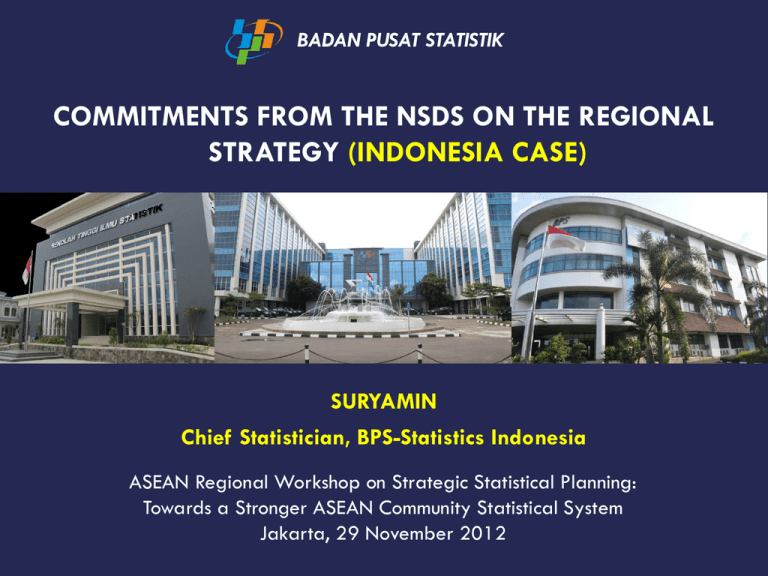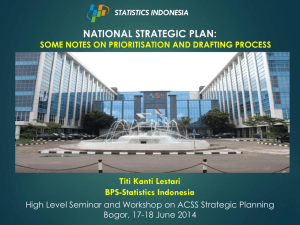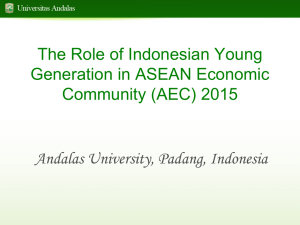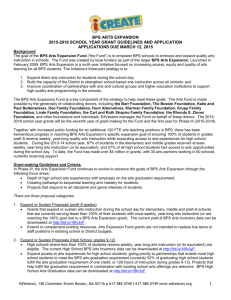MONITORING SOCIAL DEVELOPMENTS IN INDONESIA
advertisement

BADAN PUSAT STATISTIK COMMITMENTS FROM THE NSDS ON THE REGIONAL STRATEGY (INDONESIA CASE) SURYAMIN Chief Statistician, BPS-Statistics Indonesia ASEAN Regional Workshop on Strategic Statistical Planning: Towards a Stronger ASEAN Community Statistical System Jakarta, 29 November 2012 OUTLINE 1. BPS-Statistics Indonesia: Role, Vision and Mission 2. Key Challenges and BPS’s Commitments: StatcapCerdas and Bureaucratic Reform 3. Problems and Difficulties BPS: VISION AND MISSION VISION The Agent of trustworthy statistical data for all MISSION To strengthen constitutional and operational foundation of statistical agent in conducting efficient and effective statistics. To create competent and professional statistics community, supported by the latest information technology for statistical advancement in Indonesia. To increase the implementation of classification standards, concepts and definitions, measurements, and statistical codes of practice, which are universal in every statistics collection To increase the quality of statistical information services for all parties To increase coordination, integration and synchronization of statistical activities , which are collected by the Indonesian government and private institutions within the national statistical system framework of being effective and efficient KEY CHALENGES (1) 1. Steering Committee meeting of PARIS 21 (Partnership in Statistics for Development in the 21st Century) on 3 November 2004 in Paris: Encourage all countries to establish an NSDS by 2006. 2. National Bureaucratic Reform (PERMENPANRB No. 15/PER/M.PAN/7/2008) Encourage all Line Ministries to conduct bureaucratic reform to achieve Good Governance, and to improve excelent public services. 3. BPS MODERNISATION PROPOSAL: Initiatives to conduct program of Change and Reform for the Development of Statistics, called STATCAP-CERDAS program. Focus on 4 pilars improvements: a) Quality Statistics; b) ICT; c) Human Resources Development; d) Organizational Alignment. KEY CHALENGES (2) 4. Development of the Asean Community Statistical System (ACSS): Development of Strategic Plan ACSS 2010-2015 Encourage all NSOs to strengthen institutional framework, to improve quality statistics, and to facilitate technical support (capacity building). 5. Important role of NSOs: Provide based policy making through enabling comparison of data across regions, countries Provide a framework of stable, trusted, regular and coherent base of key national and international statistics BPS’ COMMITMENTS (1) 1. BPS-Statistics Indonesia has comitted to conduct a fundamental, comprehensive, and cross-sectoral change and reform program since 2008. As one of Government agency, BPS-Statistics Indonesia has also commited to implement National Bureaucratic Reform Program. STATCAP-CERDAS and Bureaucratic Reform (BR) Program is one concept of change and reform agenda. The main goal of Bureaucratic Reform Program is to achieve Good Governance. Statcap-Cerdas is the boosters for Bureaucratic Reform Program. Statcap-Cerdas/BR program is a vehicle used to achive the desired future of the BPS, as depicted in the vision of BPS to be the "The Agent of trustworthy statistical data for all“. BPS’ COMMITMENTS (2) Broad Framework Rev.1 2. Strengthen and improving the quality of statistics to support the ASEAN Economic Community in 2015. 3. BPS-Statistics Indonesia has developed the Quality Assurance Framework (QAF): as mandatory by UNSD (United Nation Statistics Division) 4. Implement ACSS (ASEAN Community Statistical System) Code of Practice → inline with BPS strategy StatCap Cerdas and Bureaucratic Reform Major Stakeholders ASEAN Statistical Framework ASEAN Statistical Indicators (ASI) SocioCultural Economic • GDP & SNA • Gov Finance • Price • Int’l Trade in Services • Manufacturing • Other Industry Sector/ Production Statistics • SME • ICT • Tourism • Int’l Merchandise Trade • Foreign Direct Investment • Transport • Infrastructure • Food Security & Prices • NDG for above PoliticalSecurity • Population • To be • Labour, considered Migration & when priority Decent Work indicators • Environment are identified • Poverty and by the APSC Wellbeing pillar • Gender (for selected AMS) • MDGs* • NDG for above Statistical Outputs/ Uses Dissemination/ Communication Data Programmes ACPMS/ ASEAN Brief • Data collection, compilation, editing and analysis • Metadata compilation & assessment • Harmonisation of classification, concepts, definitions & measurements • Adopt internationally recognised methodologies • Quality & Timeliness Yearbook Enabling Mechanisms/ Capacity Building Other publications Database/ Web-portal Press Releases Discussion Forum WGDSA to recommend the mechanism and processes • Institutional framework • Infrastructure (e.g., IT) • Data Network Communication • Statistical Devt Plan & Coordination Resource: -National/ ASEAN Governments -Donor Countries -Dialogue Partners -International Organisations * MDGs include water & sanitation, maternal & children, basic health & education, among other areas. 5. Comply to international standards in classification (such as HS, SITC, ISIC, COICOP, CPC etc) and working procedures (IMTS, SITS, SNA Manual and others) 6. Improving data dissemination and communication to users Problems and Difficulties Standard classification could not be fully implemented by other institutions due to lack of professional staff, especially at regional level. Weak coordination among data providers, especially in the regional levels due to the limited number of statisticians Lack of human resources other than statisticians (management, planner, accountant, HR specialist) ETC program mostly on trainings required for civil servants such as preemployment trainings and leadership training, but lack of technical trainings on statistics such as sampling design, computer programmer and analyst data base management, statistical analysis, office management which is needed by BPS, Lack of ICT personnel, such as programmer, system programmer, web designer, data base specialist especially in regional offices. CONCLUSIONS The key success factor of BPS development heavily rely on the availability of professional that facilitated by two knowledge centers, viz STIS in providing a new statistician, and ETC for maintaining the level of skill needed by the institutions. Human resources are very strategic area for the development of BPS: hard skill, through education and training and soft skill, through job assignments ETC should develop their program to improve technical capability to strengthen BPS coordination with sectoral data providers BPS need non statistical employees especially on HR development to strengthen BPS management. Improvement on the capacity of ICT personnel will indirectly improve most of statistical business process in producing good quality of statistics. Specific education and training programs on ICT personnel should be taken into accounts to support the ICT development and modernization of BPSStatistics Indonesia. Having better personnel database system which support the human resources improvement and development on the institution also affect to the lack of readiness of BPS in facing the target to build better, faster, cheaper, and easier services. THANK YOU Terima Kasih











![[Presentation Subject]](http://s2.studylib.net/store/data/005556214_2-3281039b7fcba92b84bbeccb43b98ca1-300x300.png)